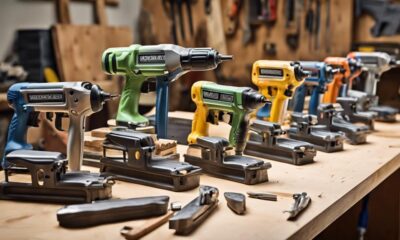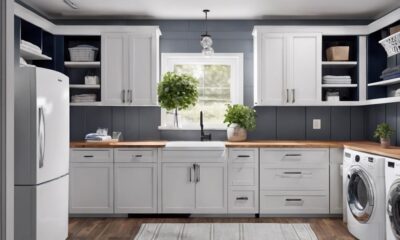Appliances
Understanding Ceiling Fan RPM: Find Out More
2025
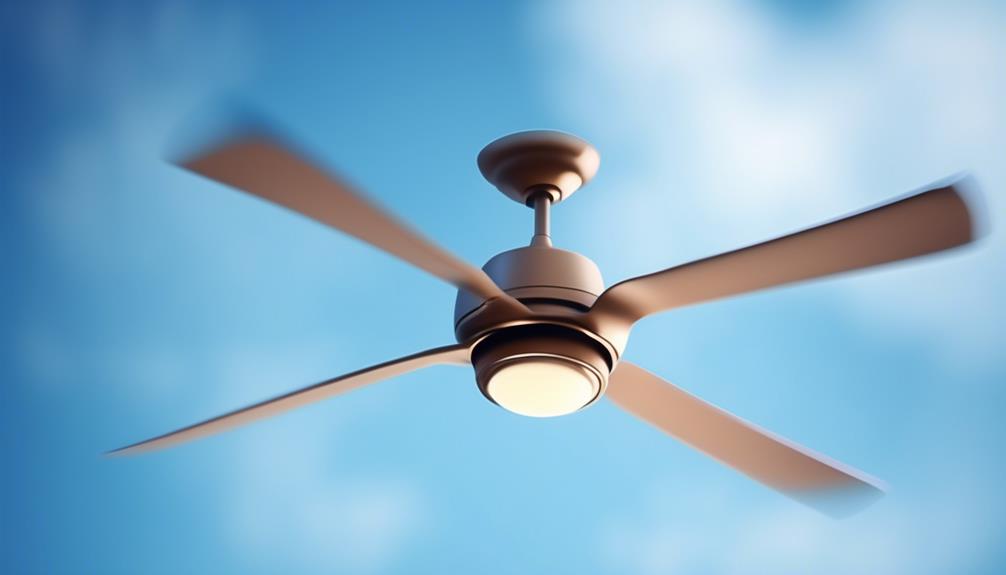
The role of RPM in a ceiling fan is critical for its airflow efficiency and overall functionality. Suppose you need a fan that’s capable of cooling a spacious room adequately. It’s vital to grasp the concept of RPM to make a knowledgeable choice.
RPM, or revolutions per minute, refers to the number of rotations the fan's blades make in one minute. This measurement directly impacts the amount of air circulated by the fan.
In this article, we will explore the importance of ceiling fan RPM, how it affects airflow, and the factors that influence RPM. By understanding the role of RPM, you can make a more informed choice when selecting a ceiling fan for your space.
Key Takeaways
- Ceiling fan RPM determines the efficiency and effectiveness of a ceiling fan.
- Setting the RPM too low can result in insufficient airflow and increased discomfort.
- Setting the RPM too high can create unnecessary noise and turbulence.
- Ceiling fan RPM directly impacts the airflow produced by the fan.
Importance of Ceiling Fan RPM
The Ceiling Fan RPM is a crucial factor that determines the efficiency and effectiveness of a ceiling fan. The importance of ceiling fan speed can't be overstated, as it directly impacts both the comfort level in a room and the energy consumption of the fan. When the RPM is set too low, the fan may not provide sufficient airflow, leading to less cooling and increased discomfort. On the other hand, when the RPM is set too high, the fan may create unnecessary noise and turbulence without providing any additional benefits.
The impact of ceiling fan RPM on energy consumption is also significant. When the fan is set at a higher RPM, it requires more electricity to operate. This increased energy consumption can lead to higher electricity bills and a greater strain on the electrical grid. Conversely, setting the fan at a lower RPM can help reduce energy consumption and save money in the long run.
It is important for individuals to find the optimal RPM for their ceiling fan based on their specific needs and preferences. By striking the right balance between comfort and energy efficiency, one can maximize the benefits of their ceiling fan while minimizing their environmental impact.
Definition of RPM for Ceiling Fans

To understand the concept of RPM for ceiling fans, it's important to define what RPM stands for and how it relates to the operation of these cooling devices. RPM stands for revolutions per minute, and it's a unit of measurement used to quantify the rotational speed of an object. In the case of ceiling fans, RPM refers to how many times the fan blades complete a full rotation in one minute.
To calculate the RPM of a ceiling fan, you need to know the motor speed. The motor speed is typically measured in rotations per minute and can be found in the fan's specifications. Once you have the motor speed, you can use it to determine the RPM of the fan blades.
The RPM of a ceiling fan is crucial because it directly affects the airflow produced by the fan. A higher RPM means that the fan blades are rotating faster, resulting in a stronger breeze and more efficient cooling. On the other hand, a lower RPM will produce a gentler airflow.
Understanding the RPM of a ceiling fan allows you to choose the right fan for your needs, whether you prefer a powerful airflow or a more subtle breeze.
How Ceiling Fan RPM Affects Airflow
After understanding the definition and importance of RPM for ceiling fans, it is now crucial to explore how the RPM of a ceiling fan directly impacts the airflow it produces. The RPM, or revolutions per minute, of a ceiling fan determines the speed at which the fan blades rotate. This rotation speed influences the airflow created by the fan, which in turn affects the temperature control and energy consumption in a room.
To better understand the relationship between ceiling fan RPM and airflow, let's examine the following table:
| Ceiling Fan RPM | Airflow Produced |
|---|---|
| Low | Gentle breeze |
| Medium | Comfortable airflow |
| High | Powerful ventilation |
As the RPM increases, the airflow produced by the ceiling fan becomes stronger. A low RPM setting generates a gentle breeze, providing a subtle cooling effect. A medium RPM setting produces a comfortable airflow, suitable for everyday use. On the other hand, a high RPM setting delivers a powerful ventilation, ideal for cooling larger spaces.
It is important to note that the impact of ceiling fan RPM on energy consumption should also be considered. Running a ceiling fan at a higher RPM requires more energy, resulting in increased electricity consumption. Therefore, it is advisable to select the appropriate RPM setting based on the desired airflow and energy efficiency.
Factors Affecting Ceiling Fan RPM
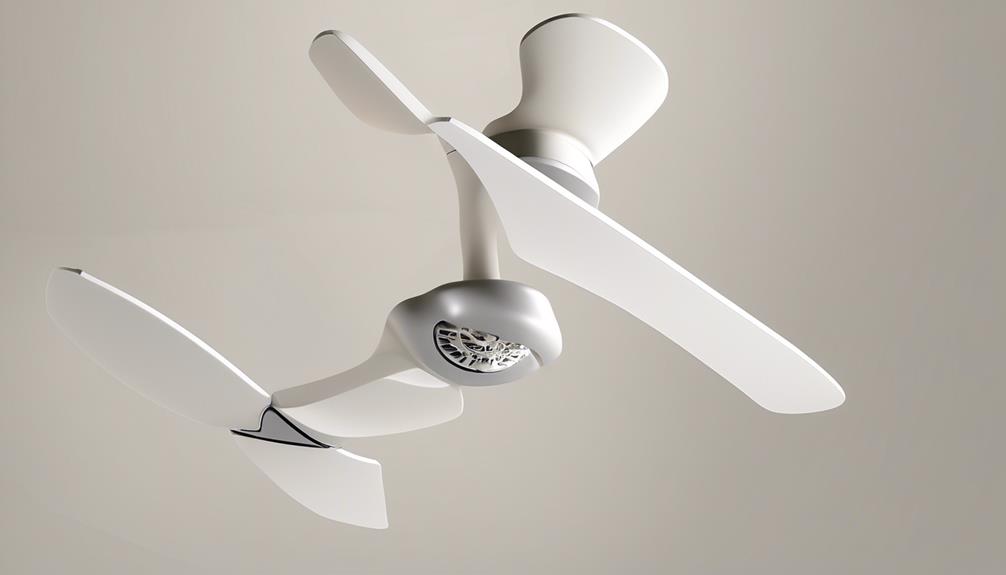
Factors that influence the RPM of a ceiling fan can be categorized into two main groups: internal factors and external factors. Let's delve into the factors affecting fan speed and the impact of blade design on RPM.
- Motor Power and Efficiency: The power of the motor plays a significant role in determining the RPM of a ceiling fan. A higher wattage motor generally results in a faster rotation speed. Additionally, the efficiency of the motor affects the fan's RPM. More efficient motors can achieve higher speeds with less power consumption.
- Blade Design: The design of the fan blades directly impacts its RPM. Factors such as blade pitch, length, and shape determine the amount of air the fan can move per revolution. Blades with a steeper pitch or larger length can generate more airflow, resulting in higher RPM. Moreover, the shape of the blades can also affect the RPM by influencing the air resistance and the ability to create a vortex for optimal air circulation.
- Load and Friction: The load on the fan, including any attachments or accessories, can affect its RPM. A heavier load can decrease the fan's speed. Additionally, friction between the moving components, such as the motor shaft and bearings, can also impact the RPM. Proper lubrication and maintenance are crucial to minimize friction and ensure optimal performance.
Understanding these factors can assist in selecting a ceiling fan that meets your specific needs and preferences. By considering motor power, blade design, and load, you can choose a fan with the desired RPM for efficient airflow in your space.
High Vs. Low RPM Ceiling Fans
When comparing high RPM ceiling fans to low RPM ceiling fans, there are two main points to consider: efficiency and comfort.
High RPM fans are more efficient at circulating air, providing better cooling in a shorter amount of time.
On the other hand, low RPM fans are known for their gentle breeze and quieter operation, offering a more relaxing and comfortable environment.
The choice between high and low RPM fans ultimately depends on the specific needs and preferences of the user.
Efficiency of High RPM
The efficiency of high RPM ceiling fans can be analyzed by comparing their performance to that of low RPM ceiling fans. When it comes to the efficiency of high RPM ceiling fans, there are several key benefits to consider:
- Improved Airflow: High RPM ceiling fans are designed to move air at a faster rate, resulting in improved airflow and better circulation in the room. This can help to cool the space more effectively and create a more comfortable environment.
- Energy Efficiency: Despite operating at higher speeds, high RPM ceiling fans are often more energy efficient compared to their low RPM counterparts. This is because they can generate a greater airflow with less power consumption, resulting in reduced energy costs.
- Enhanced Cooling Effect: Due to their ability to move air more quickly, high RPM ceiling fans can provide a more noticeable cooling effect. This can be particularly beneficial during hot summer months or in spaces with poor ventilation.
Comfort of Low RPM
High RPM ceiling fans offer a distinct advantage over their low RPM counterparts in terms of providing a more comfortable and enjoyable environment.
However, it's important to consider the benefits of low RPM ceiling fans as well.
One of the key benefits of low RPM fans is their ability to create a gentle breeze, which can be especially beneficial in spaces where a strong airflow isn't required.
Low RPM fans also tend to operate more quietly, allowing for a peaceful and serene atmosphere.
Additionally, low RPM fans are known for their energy efficiency. By operating at a lower speed, these fans consume less electricity, resulting in lower energy costs.
Understanding the RPM Rating on Ceiling Fan Labels
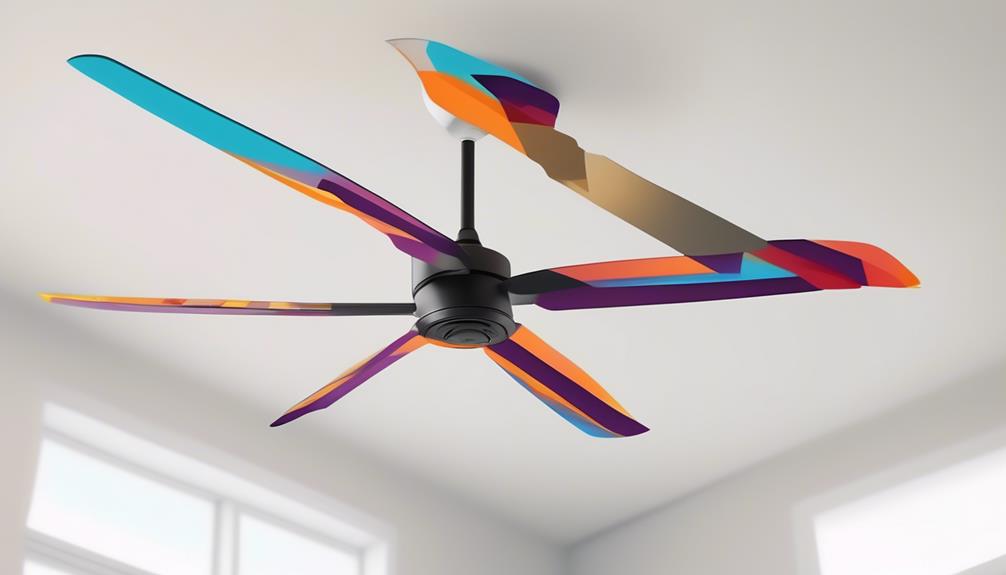
We, as consumers, can gain a better understanding of the RPM rating on ceiling fan labels by delving into the technical specifications and analyzing their significance. The RPM rating, or revolutions per minute, measures the rotational speed of the fan blades. Here are three key points to consider:
- RPM measurement techniques: Ceiling fan manufacturers typically use a tachometer to measure the RPM of their fans. This handheld device uses optical or magnetic sensors to calculate the fan's rotational speed. By accurately measuring the RPM, manufacturers can ensure that the fan operates at the specified speed.
- Impact of RPM on noise levels: The RPM rating directly affects the noise level generated by the fan. Higher RPMs generally result in louder operation due to increased air movement and blade noise. Conversely, lower RPMs tend to produce quieter operation. When choosing a ceiling fan, it's essential to consider the desired noise level and select a fan with an appropriate RPM rating.
- Significance of RPM rating: The RPM rating provides valuable information about the fan's performance. It helps determine the airflow capacity and cooling effectiveness of the fan. Fans with higher RPM ratings typically offer greater air circulation, making them suitable for larger rooms or areas that require more efficient cooling.
Choosing the Right RPM for Your Space
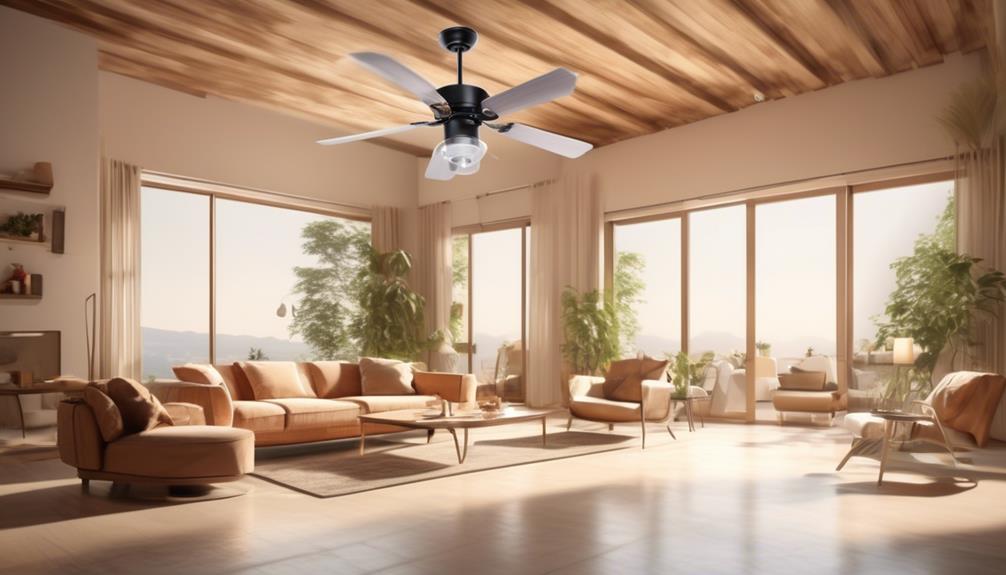
Having understood the significance of the RPM rating on ceiling fan labels, it is now imperative to determine the appropriate RPM for your specific space. Choosing the right speed for your ceiling fan is crucial in ensuring optimal comfort and airflow in your room. By adjusting the fan settings to the appropriate RPM, you can create a pleasant and refreshing environment that suits your needs.
To assist you in choosing the right RPM for your space, refer to the table below:
| Room Size | Recommended RPM Range |
|---|---|
| Small (up to 75 sq.ft) | 1,000 – 2,000 RPM |
| Medium (76 – 144 sq.ft) | 1,500 – 3,000 RPM |
| Large (145 – 225 sq.ft) | 2,000 – 4,000 RPM |
| Extra Large (226+ sq.ft) | 3,000 – 5,000 RPM |
Consider the size of your room and the desired level of airflow when selecting the appropriate RPM range. Smaller rooms may require a lower RPM to avoid excessive air movement, while larger rooms may benefit from a higher RPM to ensure adequate circulation.
How to Measure Ceiling Fan RPM
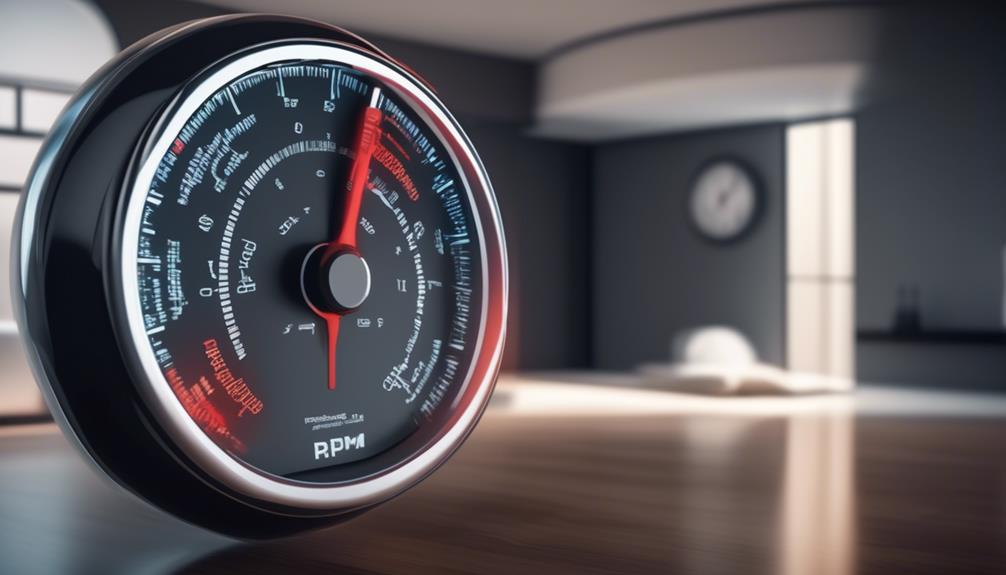
Let's talk about the points related to measuring ceiling fan RPM.
RPM, or revolutions per minute, is a crucial metric in determining the speed and performance of a ceiling fan.
To accurately measure RPM, you'll need certain tools such as a tachometer or a smartphone app capable of measuring rotational speed.
RPM Definition and Importance
To accurately measure the RPM of a ceiling fan, one must utilize a tachometer or an optical sensor for precise and reliable results. RPM, or revolutions per minute, is a critical parameter that determines the rotational speed of the fan blades. It plays a crucial role in the performance of a ceiling fan, impacting both the airflow and the comfort level in a room.
Here's why RPM is important:
- Efficiency: The RPM of a ceiling fan directly affects its overall efficiency. Higher RPMs generally result in better airflow and cooling performance, allowing the fan to circulate air more effectively.
- Airflow Control: By adjusting the RPM, you can control the amount of airflow generated by the fan. Lower RPMs provide a gentle breeze, while higher RPMs create a stronger airflow.
- Noise Level: RPM also influences the noise level produced by the fan. Optimal RPM settings can help minimize noise and ensure quiet operation.
Understanding the importance of RPM and its impact on airflow can help you choose the right settings for your ceiling fan, optimizing comfort and energy efficiency.
Tools for Measuring RPM
To accurately measure the RPM of a ceiling fan, one must utilize a device such as a tachometer or an optical sensor for precise and reliable results.
A tachometer is a tool specifically designed to measure rotational speed, making it ideal for measuring the RPM of a ceiling fan. It works by detecting changes in magnetic fields or by monitoring pulses generated by the fan's motor.
An optical sensor, on the other hand, uses light beams to detect the fan's movement and calculate its RPM.
Both tools offer advantages in terms of accuracy and ease of use.
A high RPM for a ceiling fan can provide several benefits, including increased airflow and improved cooling efficiency, making it an important factor to consider when selecting a fan for a space.
Step-by-Step Measurement Process
Continuing the discussion on measuring the RPM of a ceiling fan, we'll now explore the step-by-step process for accurately determining its rotational speed.
To ensure measuring accuracy, it's crucial to follow these steps:
- Choose a suitable measurement point: Identify a blade on the ceiling fan that's easily visible and accessible for measurement. Ideally, select a blade that's neither too close to the center nor too close to the edge.
- Mark the starting point: Use a marker to place a small dot or line on the selected blade. This mark will act as a reference point for measuring the rotation.
- Set a timer: Using a stopwatch or timer, measure the time it takes for the marked point on the blade to complete one full rotation. Repeat this process multiple times to obtain an average time.
Benefits of Higher RPM Ceiling Fans
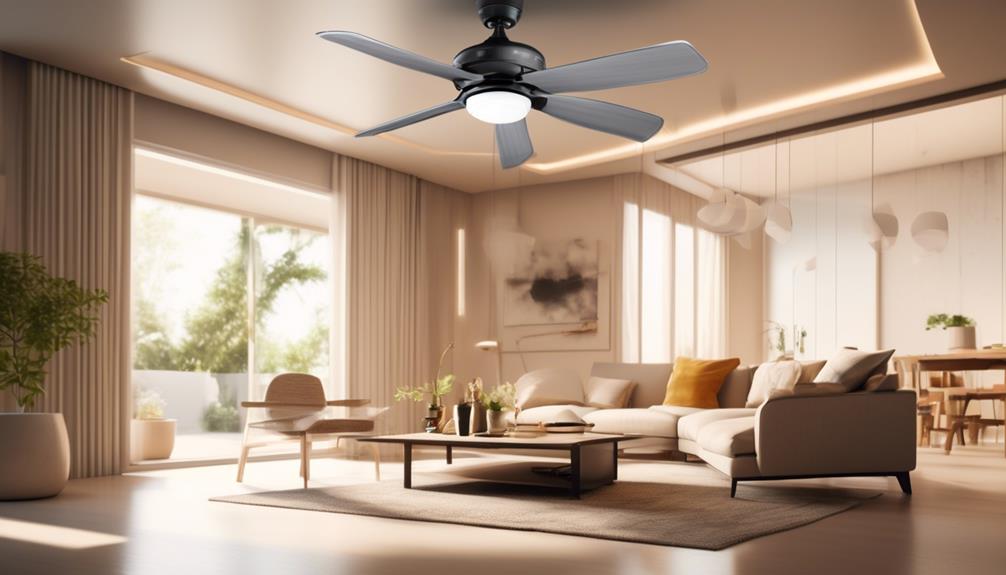
The higher RPM of ceiling fans provides improved air circulation and increased cooling efficiency. Ceiling fans with higher RPM (Revolutions Per Minute) offer several advantages over those with lower RPM. They can effectively move a greater volume of air, resulting in better ventilation and a more comfortable environment. Additionally, higher RPM fans can provide a stronger breeze, making them ideal for hot summer days or stuffy rooms.
To further illustrate the benefits of higher RPM ceiling fans, let's examine the following table:
| Advantages | Disadvantages |
|---|---|
| Improved air circulation | More noise |
| Increased cooling efficiency | Higher energy consumption |
| Stronger breeze | Limited control options |
As shown in the table, the advantages of higher RPM ceiling fans include improved air circulation, increased cooling efficiency, and a stronger breeze. However, there are also a few disadvantages to consider, such as the potential for more noise, higher energy consumption, and limited control options.
For those seeking mastery in understanding ceiling fan RPM, it is important to weigh these pros and cons when selecting a fan for your space. Consider your specific needs and preferences to determine whether a higher RPM ceiling fan is the right choice for you.
Energy Efficiency and Ceiling Fan RPM
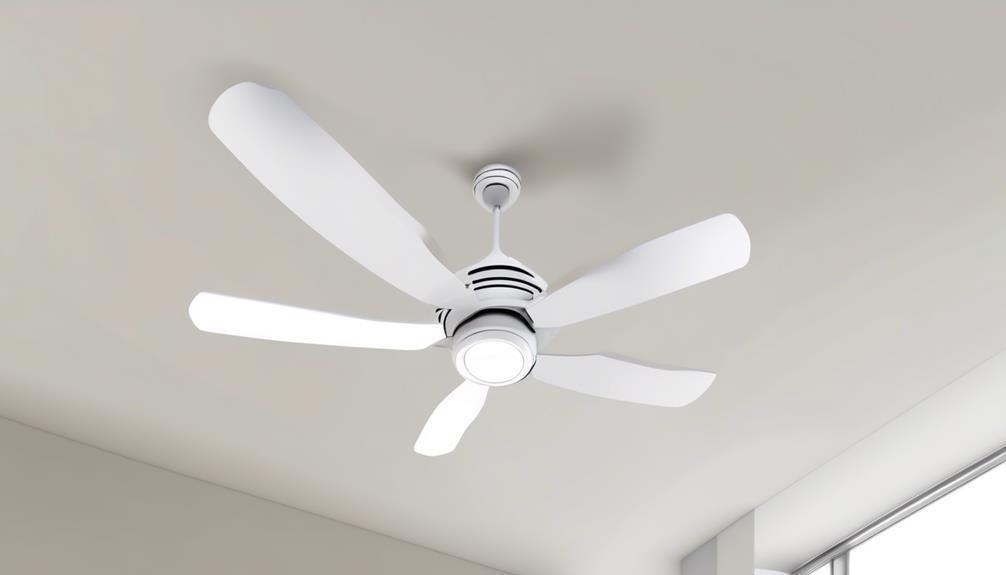
Having explored the benefits and drawbacks of higher RPM ceiling fans, we now turn our attention to the relationship between energy efficiency and ceiling fan RPM. When it comes to energy saving techniques, understanding the impact of RPM on energy consumption is crucial. Here are three key points to consider:
- RPM and Energy Consumption: The RPM of a ceiling fan directly affects its energy consumption. Higher RPM fans tend to consume more energy compared to lower RPM ones. This is because higher RPM fans require more power to rotate the blades at a faster speed, resulting in increased energy consumption.
- Variable Speed Controls: Investing in a ceiling fan with variable speed controls can significantly improve energy efficiency. These controls allow you to adjust the RPM of the fan according to your comfort needs. By running the fan at a lower RPM, you can reduce energy consumption while still enjoying a comfortable airflow.
- Efficient Motor Design: Another factor influencing energy efficiency is the motor design of the ceiling fan. Look for fans with energy-efficient motors that are specifically designed to operate at lower RPMs without sacrificing performance. These motors are engineered to consume less energy while still providing optimal airflow.
Tips for Maximizing the Performance of Your Ceiling Fan

To optimize your ceiling fan's performance, consider implementing the following tips.
Maximizing airflow is crucial for achieving optimal comfort and energy efficiency. Start by adjusting the fan speed to match your needs.
In the summer, set the fan to rotate counterclockwise at a higher speed to create a cooling breeze. This will help lower the perceived temperature in the room and reduce the reliance on air conditioning.
In the winter, set the fan to rotate clockwise at a lower speed to gently circulate warm air that tends to accumulate near the ceiling. This will help distribute heat evenly throughout the room and reduce the workload on your heating system.
Additionally, clean your fan regularly to remove dust and debris that can impede airflow. Use a soft brush or vacuum cleaner to clean the blades and motor housing. Remember to turn off the fan before cleaning and avoid using harsh chemicals.
Does Understanding Ceiling Fan RPM Help in Fixing a Slow Running Fan?
Understanding ceiling fan RPM is crucial in identifying and troubleshooting ceiling fan running slow fixes. By knowing the RPM, you can determine if the fan is operating at the right speed. Factors like improper installation, blade pitch, or motor issues can impact the RPM and lead to a slow-running fan.
Frequently Asked Questions
Can I Increase the RPM of My Ceiling Fan to Improve Its Performance?
Increasing the RPM of a ceiling fan can potentially improve its performance, but there are some drawbacks to consider.
Higher RPMs can lead to increased noise and vibration, which may be undesirable in certain situations.
Additionally, increasing the RPM beyond the recommended speed can put strain on the motor and reduce the fan's lifespan.
To determine the ideal RPM for your ceiling fan, consult the manufacturer's guidelines or consider the size of the room and the desired airflow.
Does the Size of the Ceiling Fan Affect Its Rpm?
When considering the impact of blade design on ceiling fan speed, one must also take into account the size of the fan. The size of the ceiling fan can indeed affect its RPM. Generally, larger fans tend to have a higher RPM compared to smaller ones.
This is because the larger blades are able to move a greater volume of air, resulting in a faster rotation. However, it's important to note that other factors, such as motor power and blade pitch, also play a significant role in determining the fan's RPM.
Are There Any Safety Concerns Related to High RPM Ceiling Fans?
There are indeed safety concerns related to high rpm ceiling fans.
The importance of RPM in ceiling fans lies in the fact that it directly affects the speed at which the fan blades rotate.
When the RPM is set too high, it can lead to excessive vibration and noise, which can potentially cause the fan to become unbalanced and fall.
Additionally, high RPM ceiling fans can generate strong air currents, which may pose a risk to objects and individuals in their vicinity.
Therefore, it's crucial to carefully consider and regulate the RPM of ceiling fans to ensure safe operation.
Can I Use a Variable Speed Control to Adjust the RPM of My Ceiling Fan?
Using a variable speed control to adjust the RPM of your ceiling fan can provide several benefits.
Proper ceiling fan installation is important to ensure optimal performance and efficiency.
With a variable speed control, you have the ability to adjust the fan's speed to your desired comfort level.
This allows for better air circulation, temperature regulation, and energy savings.
It's crucial to follow the manufacturer's instructions and consult a professional for proper installation and usage of a variable speed control with your ceiling fan.
Are There Any Regulations or Standards for Ceiling Fan RPM in Different Countries?
Ceiling fan rpm regulations and international standards – these are the measures that govern the speed of our beloved air-moving contraptions in different countries. From safety requirements to energy efficiency guidelines, these regulations ensure that ceiling fans operate within specified limits.
Adhering to these standards guarantees not only optimal performance but also a sense of confidence for those seeking mastery over their living spaces. So, whether you're in the market for a new fan or simply curious, understanding these regulations is key to making informed choices.
Conclusion
In conclusion, understanding the RPM of a ceiling fan is crucial in determining its performance and airflow. By measuring and considering the factors that affect RPM, such as motor power and blade design, you can choose a fan that suits your needs.
Opting for higher RPM ceiling fans can provide greater airflow and energy efficiency. By maximizing the performance of your ceiling fan, you can enjoy a cool and comfortable environment while saving on energy costs.
So, don't let the RPM spin out of your control, choose wisely for optimal comfort.
- About the Author
- Latest Posts
Introducing Ron, the home decor aficionado at ByRetreat, whose passion for creating beautiful and inviting spaces is at the heart of his work. With his deep knowledge of home decor and his innate sense of style, Ron brings a wealth of expertise and a keen eye for detail to the ByRetreat team.
Ron’s love for home decor goes beyond aesthetics; he understands that our surroundings play a significant role in our overall well-being and productivity. With this in mind, Ron is dedicated to transforming remote workspaces into havens of comfort, functionality, and beauty.
Garage Door Opener
Install a Keypad Garage Door Opener: 7 Easy Steps
Start your journey to effortless garage access with seven simple steps to installing a keypad opener – discover the first step now!
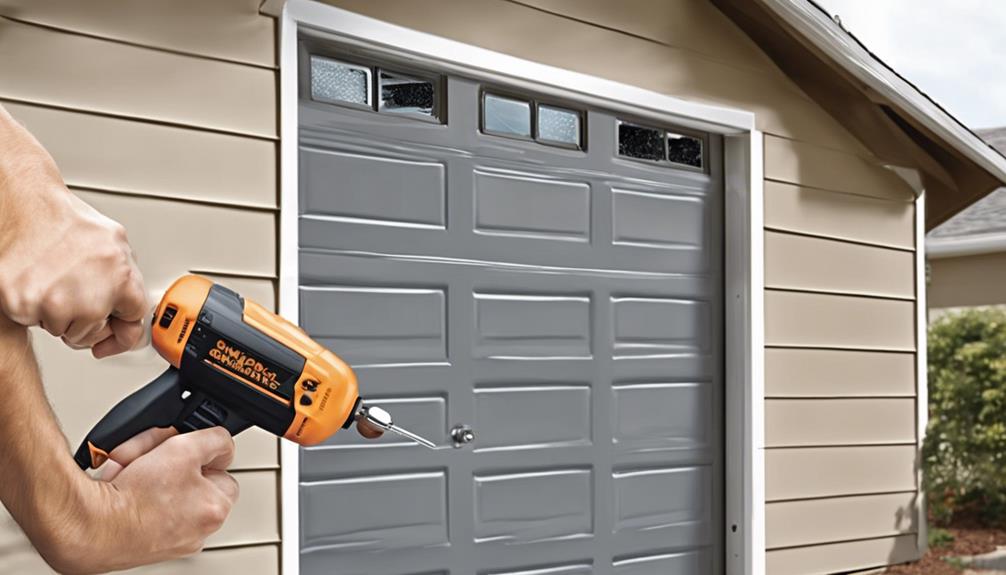
When it comes to setting up a keypad garage door opener, we have you covered with seven simple steps to follow.
From selecting the right keypad to troubleshooting any potential issues that may arise, each step is designed to make the process seamless and efficient.
By taking the time to carefully walk through each of these steps, you'll be able to enjoy the convenience and peace of mind that a keypad garage door opener can offer.
Key Takeaways
- Choose an ideal, accessible location for keypad placement near the garage door.
- Ensure compatibility and securely mount the keypad for optimal functionality.
- Program a unique, secure PIN for the keypad and test functionality thoroughly.
- Maintain security by changing the code periodically, monitoring battery levels, and keeping the keypad clean.
Gather Necessary Tools and Materials
To begin the installation process of a keypad garage door opener, gather the necessary tools and materials, ensuring you have everything required for a successful installation. For this project, you'll need a wireless keyless entry pad, stainless steel screws, a tape measure, sharpened pencil, and a level. Additionally, a cordless drill, 3/32 drill bit, Philips head screwdriver, and a step stool will be necessary to complete the installation efficiently.
Proper measurement and marking the center of the garage door jam are crucial steps to ensure accurate keypad placement. Once you have determined the ideal location, secure the keypad using the provided screws and check alignment with a level to guarantee a professional finish.
Programming the keypad is the next vital step. Follow the specific instructions provided, such as pressing the yellow learn button on the garage door opener and entering a four-digit code. This process is essential to ensure that your garage door keypad operates smoothly and securely.
Locate the Ideal Placement
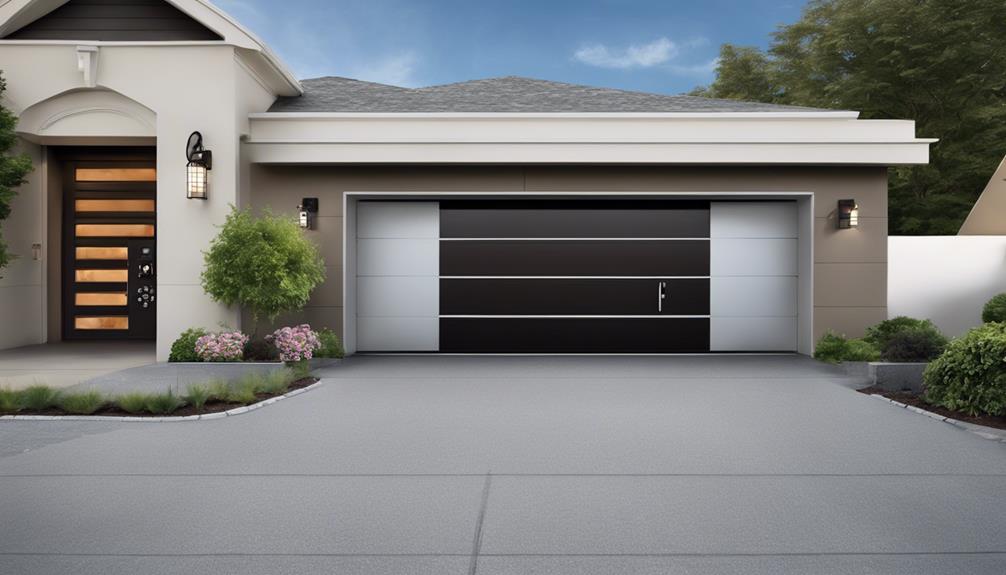
When positioning a keypad garage door opener, we must carefully select an optimal location that balances accessibility and security concerns.
Placing the keypad near the garage door ensures convenient access while avoiding direct sunlight exposure to prevent premature wear.
Additionally, choosing a discreet location that isn't easily visible from public view enhances the overall security of the system.
Choose Optimal Position
For optimal functionality, place the keypad in a location near the garage door that balances accessibility and security. When choosing the optimal position for your garage door opener keypad, consider the following:
- Proximity to the Garage Door: Ensure the keypad is within easy reach when you need to enter the garage quickly.
- Sunlight Exposure: Avoid installing the keypad in direct sunlight to prevent potential damage and ensure longevity.
- Visibility: Select a spot that isn't easily visible from the street to enhance the security of your garage.
- Signal Strength: Test the signal strength in the chosen location to confirm that it's suitable for reliable operation.
Following these guidelines will help you find the perfect spot for your keypad opener for convenient and secure access into your garage.
Consider Accessibility Factors
Considering the optimal placement for your keypad garage door opener, position it strategically near the garage entrance to ensure convenient access and smooth operation. This placement allows for quick entry without having to walk too far from your vehicle. To help you visualize the ideal positioning, refer to the table below:
| Location | Accessibility |
|---|---|
| Near Garage Entrance | Convenient Access |
| Avoid Sunlight Exposure | Prevents Keypad Damage |
| Not Visible from Street | Enhances Security |
Prepare the Garage Door Opener
Before proceeding with the keypad installation, it's crucial to ensure compatibility between the garage door opener and the keypad.
Gather all the required tools as specified in the manual or manufacturer's guidelines.
Clear the workspace around the garage door opener to facilitate a smooth and efficient installation process.
Check Opener Compatibility
To ensure a seamless integration, our first step involves verifying the compatibility of the keypad with your specific garage door opener model. Here are the key aspects to consider when checking opener compatibility:
- Manufacturer Guidelines: Refer to the manufacturer's guidelines to ensure the keypad is suitable for your specific garage door opener.
- Programming Requirements: Verify the keypad's frequency and programming requirements to match your garage door opener's settings.
- Security Features: Confirm the keypad's compatibility with the security features of your garage door opener for smooth operation.
- Adapter Compatibility: Research any additional adapters or accessories needed to connect the keypad to your garage door opener effectively.
Gather Required Tools
After ensuring the compatibility of the keypad with your specific garage door opener, the next step is to gather the required tools for preparing the garage door opener.
To install the wireless keypad, you'll need stainless steel screws (#6 x 1 inch) to securely mount it. Ensure precision by measuring and marking the center of the garage door jam for accurate placement. Use a 3/32 drill bit to create pilot holes before attaching the keypad with the screws.
Align the keypad using a level to guarantee it's positioned correctly before the final installation. These steps are crucial to ensure a smooth and successful button installation process on your garage door.
Clear Workspace Area
Let's ensure the workspace is clear and optimized for the installation of the keypad garage door opener by removing any clutter or obstacles near the garage door opener.
- Clear the Area: Remove any tools, boxes, or items that could hinder the installation process.
- Ensure Ample Space: Make sure there's enough room to work comfortably around the garage door opener.
- Organize Tools: Arrange your tools neatly within reach to streamline the keypad installation.
- Check for Obstructions: Inspect the area for any potential obstacles that could impede the process.
A clutter-free workspace area not only facilitates the installation of the keypad garage door opener but also enhances efficiency and safety during the installation process.
Mount the Keypad
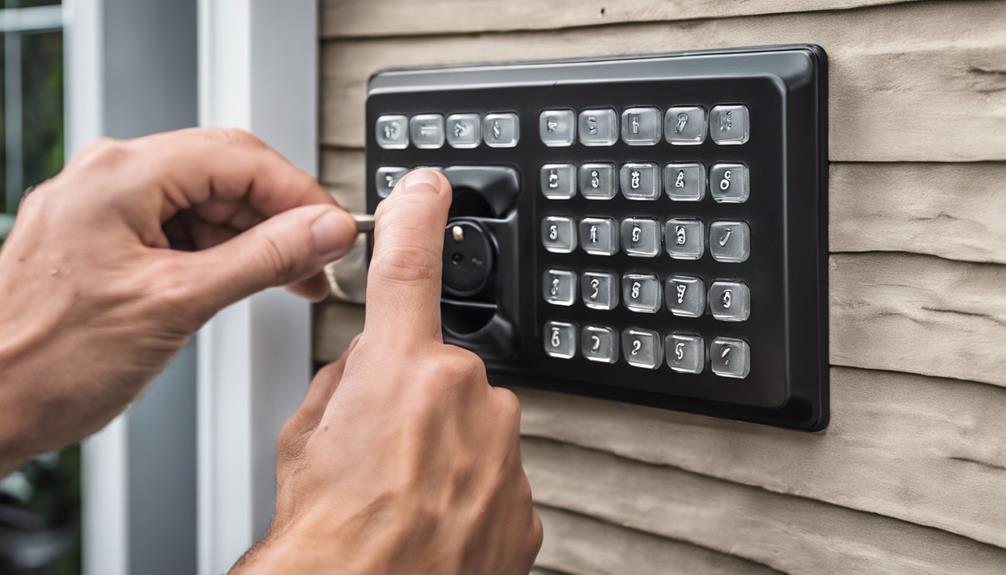
Position the keypad at a comfortable height for access, typically around 5 feet from the ground, ensuring it is straight using a level on the garage door jamb. To securely mount the keypad, follow these steps:
| Steps | Actions |
|---|---|
| 1. Mounting Height | Position keypad at 5 feet for easy access. |
| 2. Alignment | Ensure keypad is straight using a level. |
| 3. Screw Placement | Secure keypad using screws provided in the kit. |
| 4. Avoid Damage | Do not over-tighten screws to prevent damage. |
| 5. Functionality | Test keypad post-installation for proper usage. |
Mounting the keypad correctly is crucial for convenient access and functionality. Once you've securely attached the keypad, be sure to test its functionality to ensure it's working correctly. By following these steps, you'll have your keypad mounted at a comfortable height, ready to make accessing your garage a breeze.
Connect Wiring (If Applicable)
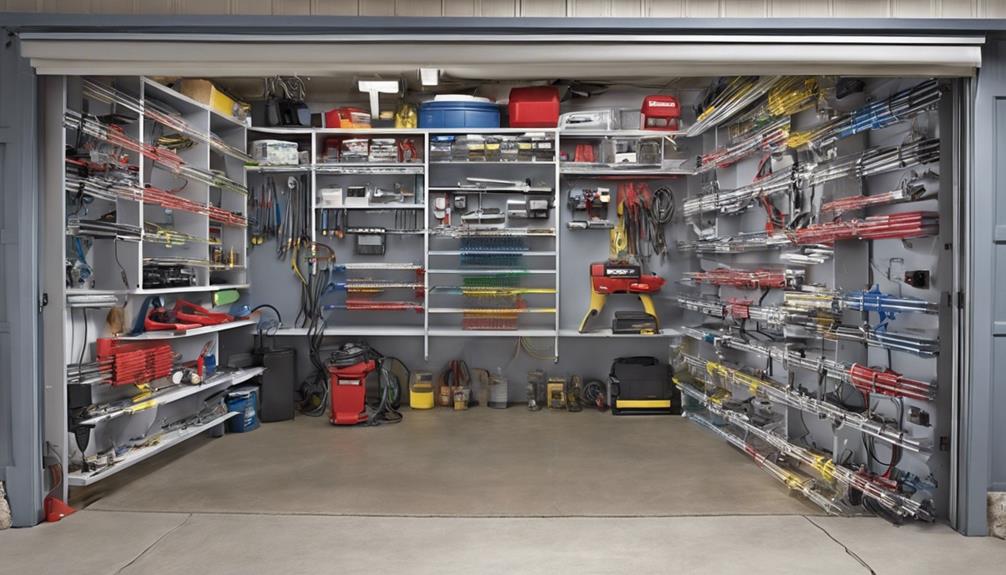
Having securely mounted the keypad at the appropriate height, the next step is to connect any wiring necessary for its operation, following safety precautions and manufacturer guidelines. Before proceeding, ensure the power is off to prevent any electrical hazards. Here are some essential steps to successfully connect the wiring:
- Follow Manufacturer's Instructions: Refer to the manufacturer's guidelines for the specific wiring configurations to prevent any damage to the keypad or garage door opener system.
- Use Proper Tools: Utilize wire strippers to prepare the ends of the wires and connectors to make a secure connection between the keypad and the garage door opener.
- Secure Wiring: Connect the colored wires to the matching terminals on the garage door opener, utilizing the second screw to secure each wire in place.
- Test Keypad Functionality: Once the wiring is connected, test the keypad to ensure it's functioning correctly before completing the final installation.
Program the Keypad
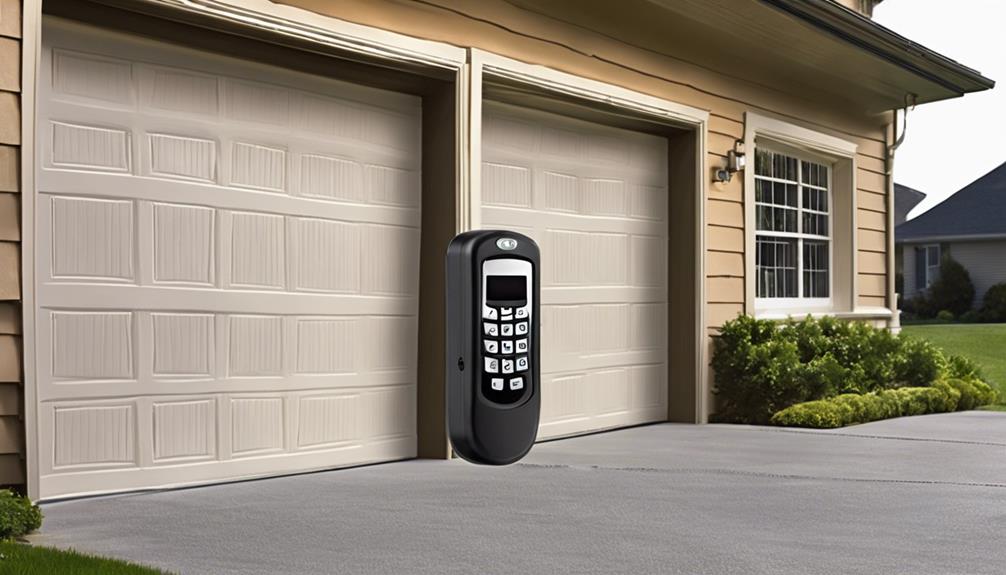
To successfully program the keypad for your garage door opener, initiate the process by pressing and releasing the 'Learn' button on the motor unit. Once you've completed this step, the motor unit's lights will illuminate, indicating it's ready for programming.
Now, enter a unique four-digit PIN on the remote keypad for your garage door within 30 seconds and hold the 'ENTER' key. It's crucial to ensure all required fields are marked accurately during this process. After entering the code, release the 'ENTER' button.
If the programming is successful, you'll observe the motor unit lights blinking or hear two clicks. This confirms that the code has been successfully set. Remember, picking a code that's easy for you to remember but hard for others to guess is essential for security.
If needed, you can always change the code later to maintain the safety of your garage.
Test and Adjust for Proper Function
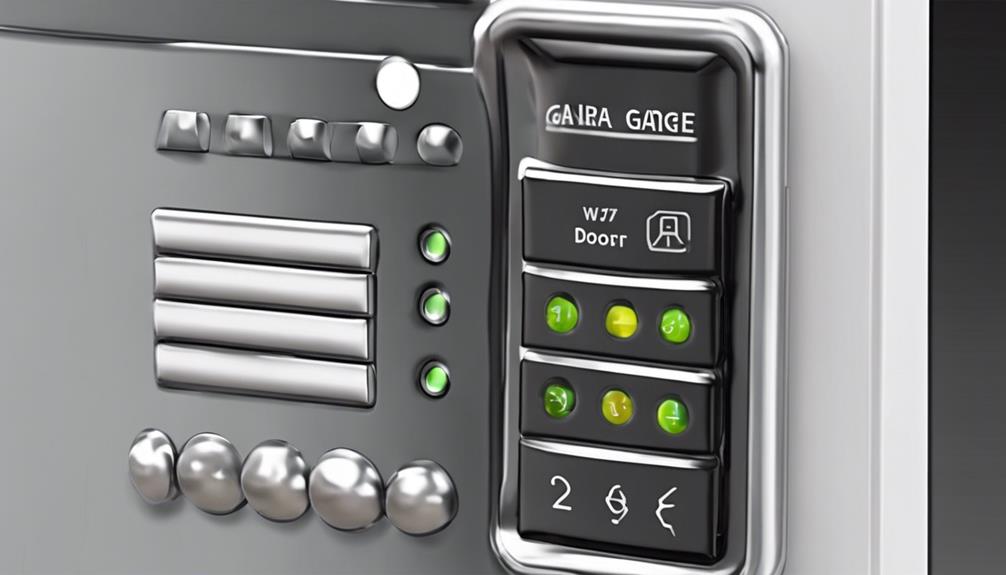
After successfully programming the keypad for your garage door opener, the next step is to test and adjust for proper function to ensure optimal performance.
- Test the Keypad: Enter the programmed code and observe how the garage door responds. This will confirm that the keypad is communicating effectively with the opener.
- Check Battery Power: Ensure the keypad has sufficient battery power for proper functioning. Low battery levels can lead to connectivity issues.
- Adjust Position: If the signal strength is weak or there are connectivity problems, consider repositioning the keypad. This can improve communication with the garage door opener.
- Secure Installation: Verify that the keypad is securely mounted to prevent any movement that could affect its operation. A stable installation is crucial for consistent performance.
Frequently Asked Questions
How Do You Install a Garage Door Opener Keypad?
We install a garage door opener keypad by:
- Determining compatibility with our opener
- Choosing a convenient location
- Programming a secure PIN
- Testing functionality
- Following manufacturer guidelines for proper installation
It's essential to ensure the keypad operates effectively with the door. By following these steps, we guarantee a smooth installation process and optimal performance for our garage door opener keypad.
Can You Add a Keypad to an Existing Garage Door Opener?
Yes, we can definitely add a keypad to an existing garage door opener. It's a straightforward process that enhances security and convenience. By entering a unique code, we can easily open and close the garage door without relying on traditional remote controls.
Keypads are a great alternative, offering easy access to our garage. This upgrade is a simple way to make our garage more accessible and user-friendly.
What Is the Easiest Garage Door Opener to Install?
We find that the Liftmaster 877LM Wireless Keyless Entry is the easiest garage door opener to install. It's compatible with most Liftmaster, Chamberlain, and Sears Craftsman models. Programming is straightforward by pressing the 'learn' button and entering a unique four-digit code.
This keypad provides convenient access without needing a remote control. For those seeking a DIY project, the Liftmaster 877LM with its simple installation process and user-friendly programming is a top choice.
Which Is Better Wired or Wireless Garage Door Keypad?
When deciding between wired or wireless garage door keypads, we prefer wireless for its ease of installation and flexibility in placement. Wireless keypads are generally simpler to set up and can be relocated with minimal effort.
While wired keypads offer a more stable connection, they require additional expertise for installation. Consider factors like convenience, range, and compatibility with your opener before making a decision.
Conclusion
In conclusion, installing a keypad garage door opener is a breeze with these 7 easy steps.
With just a few tools and materials, you can enhance the accessibility and security of your garage in no time.
By following our detailed guide, you'll be able to program the keypad and ensure it functions flawlessly.
Say goodbye to fumbling for your keys and hello to the convenience of a keypad garage door opener!
- About the Author
- Latest Posts
Introducing Ron, the home decor aficionado at ByRetreat, whose passion for creating beautiful and inviting spaces is at the heart of his work. With his deep knowledge of home decor and his innate sense of style, Ron brings a wealth of expertise and a keen eye for detail to the ByRetreat team.
Ron’s love for home decor goes beyond aesthetics; he understands that our surroundings play a significant role in our overall well-being and productivity. With this in mind, Ron is dedicated to transforming remote workspaces into havens of comfort, functionality, and beauty.
Garage Door Opener
5 Easy Steps to Program Your Toyota Highlander Garage Door Opener
Open the door to seamless integration between your Toyota Highlander and garage – discover the effortless 5-step process now!
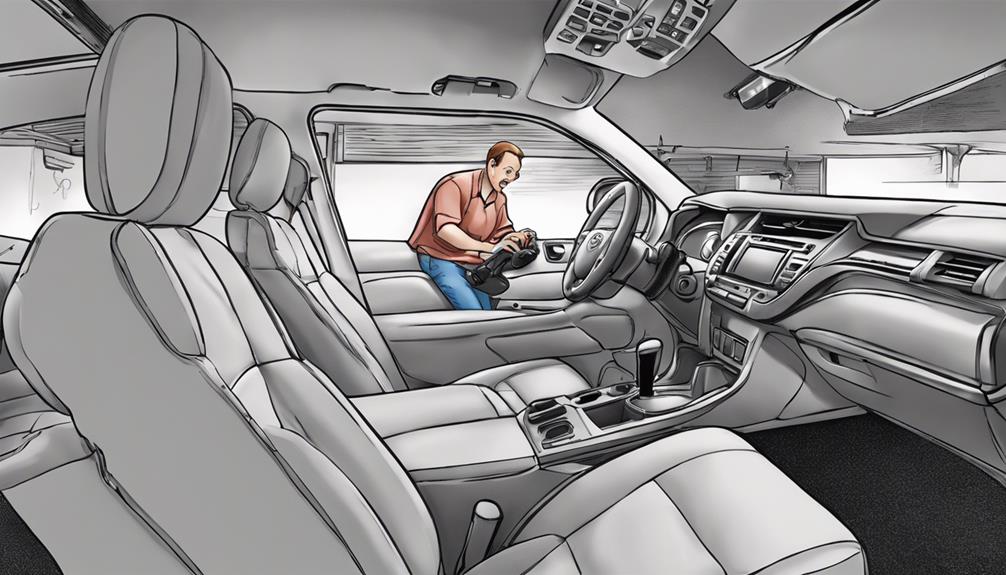
When it comes to syncing the garage door opener on your Toyota Highlander, the process is as simple as a leisurely Sunday drive.
But what if I told you there's a way to make it even simpler?
By following these 5 easy steps, you can effortlessly program your garage door opener without any hassle.
So, why not discover how to seamlessly integrate your vehicle with your home's security system in just a few simple steps?
Key Takeaways
- Locate HomeLink buttons on overhead console or rearview mirror.
- Clear existing programming by holding two outside buttons.
- Pair by selecting programming option 2 and holding desired buttons.
- Test connection for smooth operation, finalize by confirming successful programming.
Locate the HomeLink Buttons
To begin programming your Toyota Highlander garage door opener, make sure to locate the HomeLink buttons on the overhead console or integrated into the rearview mirror. These buttons are easily identifiable by the symbol of a house or three dots, ensuring convenient access for the driver. The strategic placement of the HomeLink buttons in the Highlander guarantees easy visibility and accessibility for programming the garage door opener.
When looking for the HomeLink buttons, you'll find them ideally positioned within arm's reach, allowing for effortless interaction while maintaining focus on the road. Whether located on the overhead console or integrated into the rearview mirror, the design ensures that your garage door opener programming process is seamless and user-friendly.
Clear Existing Programming
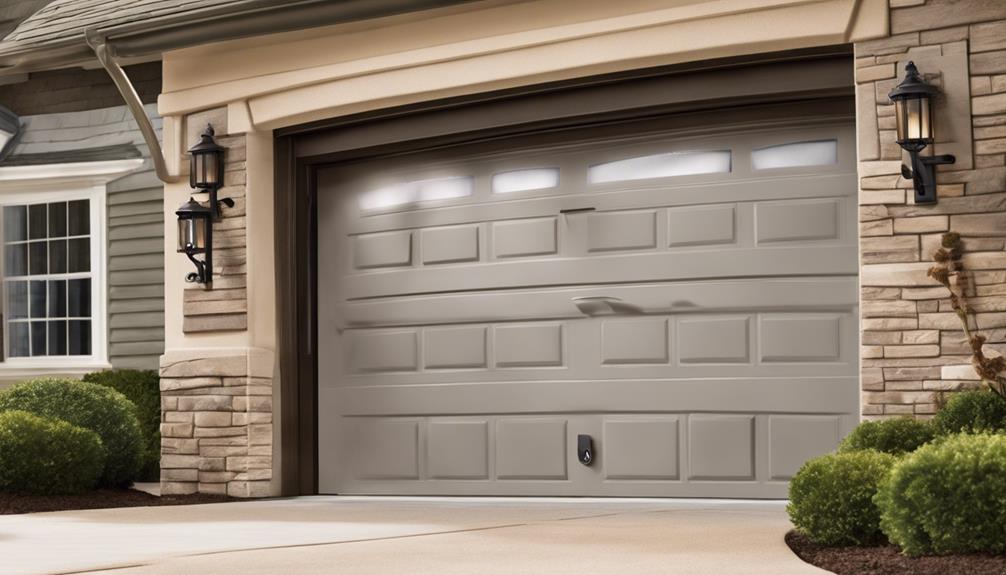
Before proceeding with reprogramming the garage door opener on your Toyota Highlander, it's essential to clear any existing programming to ensure a smooth setup process.
To clear the existing programming, follow these steps:
- Hold down the two outside buttons on the Homelink system simultaneously.
- Keep holding the buttons until the indicator light starts flashing rapidly.
- Once the light flashes rapidly, the previous programming is successfully erased, indicating that you can now proceed with reprogramming your garage door opener.
Clearing existing programming is a crucial step as it removes any previous settings that could potentially cause conflicts during the new programming process. By following these simple steps, you can quickly clear the existing programming on your Toyota Highlander garage door opener, setting the stage for a successful setup.
Pair With Garage Door Opener
Pair your Toyota Highlander's Homelink Garage Door Opener effortlessly by following these straightforward steps. To begin, ensure your vehicle is parked outside the garage with the ignition on.
Select programming option 2 on the Homelink system, then simultaneously press and hold the desired Homelink button and the button on your garage door opener. The indicator light on the Homelink system will flash slowly, then rapidly. Keep both buttons pressed until the light changes from rapid to solid. This process may take up to 30 seconds.
It's crucial to place the garage door opener within a few inches of the Homelink system during pairing for optimal results. Once the pairing is successful, the Homelink system will control your garage door, providing a seamless and integrated experience.
Say goodbye to separate remote controls as your Toyota Highlander gains a new level of convenience and functionality.
Test the Connection
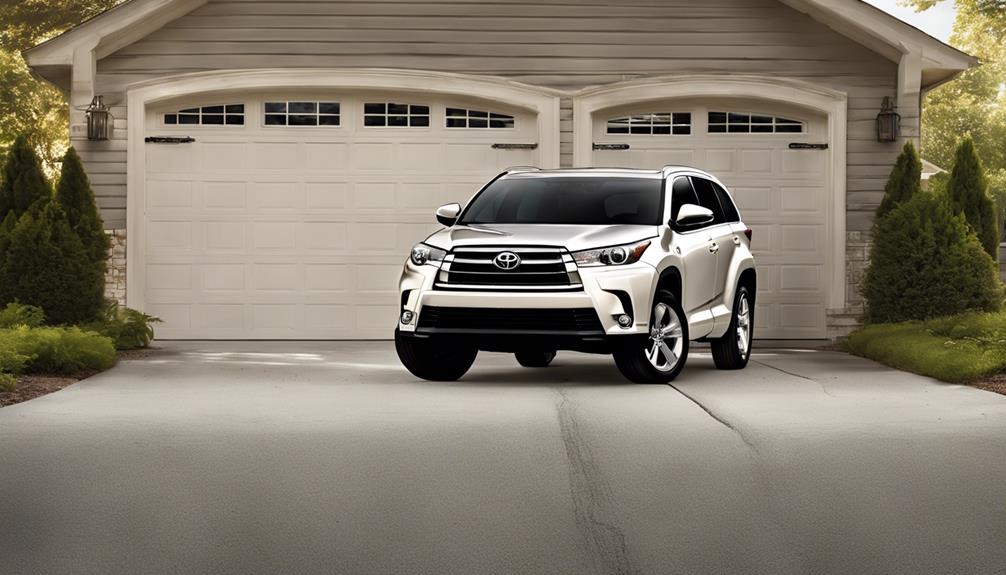
Upon successfully programming the Homelink system in your Toyota Highlander, the next step is to test the connection to ensure seamless functionality. To do this, follow these steps:
- Confirm Homelink Light: Make sure that the Homelink indicator light in your vehicle is flashing rapidly, indicating that the programming was successful.
- Test Garage Door Opener: Press the button in the vehicle that you programmed to operate your garage door. This action should prompt the garage door to either open or close, demonstrating that the connection is working correctly.
- Verify Smooth Operation: Ensure that the garage door responds promptly and smoothly to the commands sent from your Toyota Highlander. If there are any issues with the operation, you may need to troubleshoot by reprogramming or checking compatibility with the garage door opener.
Testing the connection is crucial to guarantee that your Toyota Highlander's Homelink system effectively controls your garage door, providing you with the convenience and security you desire.
Finalize the Programming
To ensure the seamless operation of your Toyota Highlander's Homelink system with your garage door opener, the next step is to finalize the programming process. Once you've successfully programmed the Homelink buttons according to the manufacturer's instructions, it's crucial to confirm the programming by observing the garage door opener's LED light. The LED light should flash rapidly, indicating that the programming was successful.
After confirming the programming, it's essential to test the Homelink system by pressing the programmed button to operate the garage door. If the garage door responds appropriately to the Homelink system's command, congratulations! You can now enjoy the convenience of opening and closing your garage door effortlessly from your Toyota Highlander.
In the event that the garage door doesn't respond to the Homelink system, don't worry. You can simply repeat the programming process to ensure accuracy. If programming issues persist despite multiple attempts, feel free to contact Toyota customer support for further assistance. With these final steps, your Toyota Highlander's garage door opener programming should be successfully completed.
Frequently Asked Questions
How Do I Program My Garage Door Opener on My Highlander?
To program your garage door opener on your Highlander, we need to select programming option 2. Place the opener near the Homelink system, then press both system buttons simultaneously.
Wait for the rapid flashing light, indicating successful programming. Enjoy the convenience of opening and closing your garage door with your Highlander's Homelink system.
These steps are simple and quick, ensuring seamless operation of your garage door opener with your vehicle.
How Do I Sync My Garage Door Opener to My Car?
To sync your garage door opener to your car, follow these steps:
- Hold your opener remote close to the Homelink buttons.
- Simultaneously press and hold both the garage door opener and Homelink buttons until the light flashes rapidly.
- Your opener is now synced to your vehicle.
Enjoy the ease of opening and closing your garage door with your Toyota Highlander's Homelink system.
How Do I Clear My Toyota Garage Door Opener?
To clear your Toyota garage door opener, follow these steps:
- Press and hold the two outside buttons on the Homelink system until the indicator light flashes rapidly.
- Continue holding until the light changes from a slow to a rapid flash.
- Once the light flashes rapidly, indicating the programming has been cleared, release the buttons.
Now, your Toyota garage door opener is reset and ready for new programming.
Why Won't My Garage Door Opener Program to My Car?
We've encountered the frustration when our garage door opener won't sync with the car.
It's essential to verify compatibility, follow precise programming steps, and ensure proper battery function.
Don't forget to eliminate any potential obstacles during the process.
If the issue persists, reaching out to Toyota support or a professional is the next step for assistance.
Conclusion
In conclusion, we've successfully programmed our Toyota Highlander garage door opener in just 5 easy steps. Our Homelink system is now synced with the garage door opener, providing us with the convenience and security we desire.
With this simple integration, we can effortlessly open and close our garage door using our vehicle. Say goodbye to the days of manually operating your garage door, and embrace the future of technology with your Toyota Highlander.
- About the Author
- Latest Posts
Introducing Ron, the home decor aficionado at ByRetreat, whose passion for creating beautiful and inviting spaces is at the heart of his work. With his deep knowledge of home decor and his innate sense of style, Ron brings a wealth of expertise and a keen eye for detail to the ByRetreat team.
Ron’s love for home decor goes beyond aesthetics; he understands that our surroundings play a significant role in our overall well-being and productivity. With this in mind, Ron is dedicated to transforming remote workspaces into havens of comfort, functionality, and beauty.
Garage Door Opener
Clearance Garage Door Opener Installation Guide
Navigate the complexities of installing a garage door opener with ample overhead clearance, uncovering the key steps for a seamless setup.
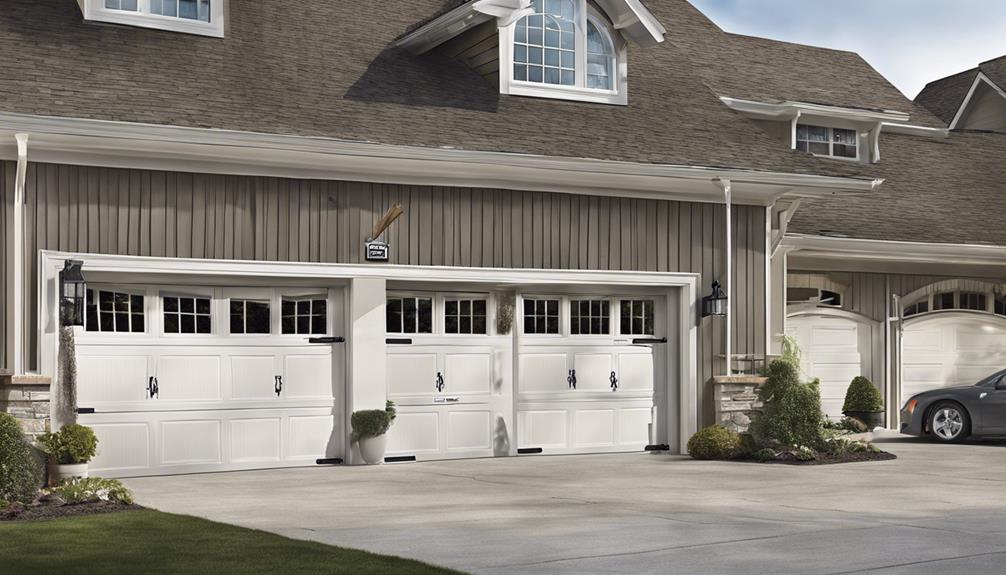
Have you ever thought about the details involved in installing a garage door opener with enough overhead clearance? How difficult is it to make sure the installation is smooth and guarantees the best performance? Well, don’t worry, as we will walk you through the necessary steps for getting your garage door opener set up.
From measuring overhead space to selecting the right opener and testing its functionality, our discussion will equip you with the necessary knowledge to tackle this task effectively. Let's unravel the secrets to a successful garage door opener installation together.
Key Takeaways
- Accurate measurement and ample clearance space are crucial for smooth installation.
- Choose a low-profile opener for limited headroom, featuring modern connectivity and quiet operation.
- Prepare a clutter-free workspace with proper lighting for efficient installation.
- Test functionality thoroughly, adjusting as needed for safe and optimal garage door operation.
Measure Overhead Clearance Space
To ensure proper installation of the garage door opener, it's crucial to accurately measure the overhead clearance space between the top of the garage door and the ceiling. The vertical space is essential for the garage door opener and its components to operate smoothly and without any hindrances.
When measuring the overhead clearance, take into account the drive garage door opener's specifications provided by the manufacturer. These specifications will outline the required vertical space needed for the specific model being installed. Additionally, consider any extra accessories or modifications that may impact the overhead clearance space, ensuring that there's ample room for safe and efficient operation.
Select Low-Profile Garage Door Opener
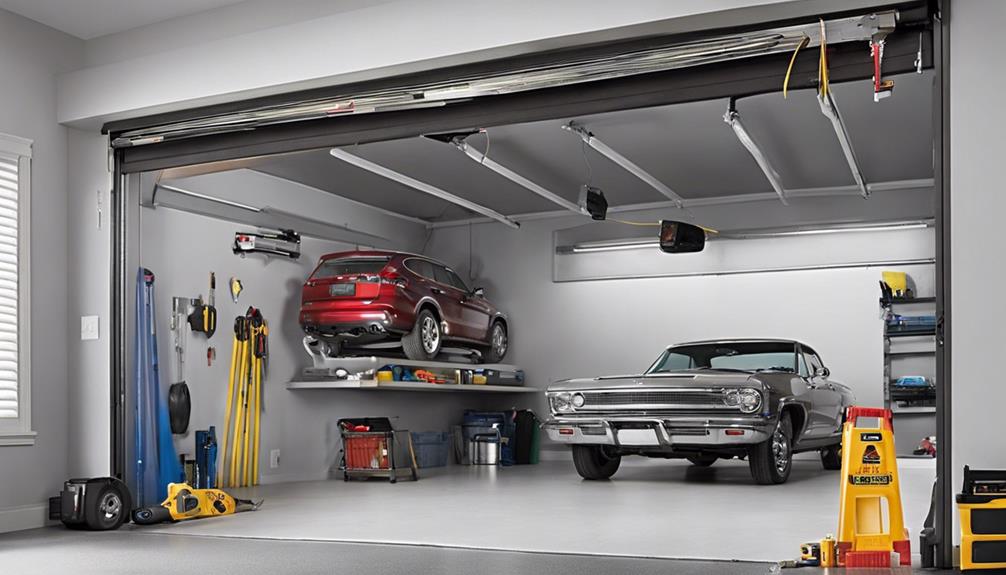
Having ensured the adequate overhead clearance space for the garage door opener installation, the next step is to carefully select a low-profile garage door opener that fits snugly in tight spaces while offering advanced features and compatibility with various door types.
Low-profile garage door openers are specifically designed to accommodate limited headroom situations, making them perfect for garages with space constraints. Their compact and sleek design allows for discreet installation without occupying much room. These openers often come equipped with modern conveniences like smartphone connectivity, battery backup, and quiet belt drive operation for a seamless user experience. Additionally, their compatibility with a range of garage door sizes and types provides installation flexibility.
Energy efficiency is another advantage, as low-profile garage door openers can help reduce electricity consumption, leading to potential long-term cost savings. When choosing a low-profile garage door opener, consider factors such as the size of your garage door and the desired features for optimal performance.
Prepare Workspace for Installation
Clearing the area around the garage door opener is essential to provide ample space for a smooth installation process. Before beginning the installation of the garage door opener, it's crucial to ensure that there are no obstructions or clutter that may hinder the process.
By creating a clean and organized workspace, you can work efficiently and safely. Remove any tools or items that may interfere with the installation of the garage door opener to streamline the process. Keeping the workspace well-lit and free from distractions will allow you to focus on the installation tasks at hand.
Install Opener According to Manual
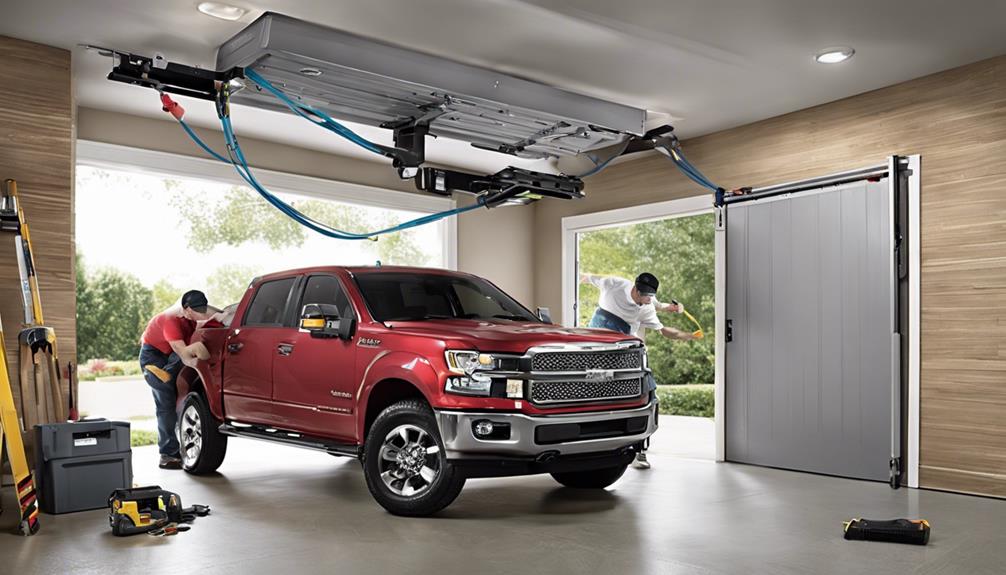
Following the manufacturer's manual meticulously is crucial for the precise installation of the garage door opener. To ensure a successful installation, our team recommends the following steps:
- Positioning Components: Properly position and secure all garage door opener components as instructed in the manual. This ensures the safe and efficient operation of the opener.
- Connecting Wiring: Connect all wiring and mechanisms according to the manual's specifications. Proper connection is vital to prevent malfunctions and ensure smooth functioning of the garage door.
- Adhering to Guidelines: Adhere strictly to the manual's guidelines for installing the opener. These guidelines are designed by professional garage door experts to guarantee a correct and secure installation.
Test Functionality and Adjust if Needed
To ensure the garage door opener functions smoothly and safely, thorough testing and potential adjustments are essential. Begin by testing the garage door's opening and closing functionality multiple times to guarantee a seamless operation.
Listen for any unusual sounds and watch out for jerky movements or obstructions that may impede the door's movement. If any issues arise, consider adjusting the opener's settings to enhance the door's operation and clearance within the garage space.
It's crucial to verify that the door clears the opening without any problems or interference. Additionally, confirm that the safety sensors are operational and don't hinder the door's movement in any way, ensuring a safe and efficient garage door operation.
Frequently Asked Questions
How Much Clearance Do You Need to Install a Garage Door Opener?
We need a minimum of 2 inches of clearance above the garage door for installing most openers. It's crucial to check the manufacturer's specifications for the exact clearance required by your specific opener model.
Taller doors or special opener features may demand more clearance. The needed space can vary depending on the opener type, like chain-drive, belt-drive, or screw-drive.
Adequate clearance ensures smooth opener operation and prevents door movement interference.
What Is the Minimum Clearance Above a Garage Door for an Opener?
We need at least 2 inches of clearance above a garage door for an opener to work effectively. Some models might require up to 3 inches, depending on their design. Too little space can lead to operational issues and potential damage.
It's crucial to measure accurately before installing to avoid problems. Always refer to the manufacturer's guidelines for the specific opener model to ensure the right clearance.
How Much Does Lowes Charge to Install a Garage Door Opener?
We love the convenience of Lowe's garage door opener installation services, starting at $127, with pricing varying based on installation complexity.
Extra charges may apply for services like removing old openers or installing new electrical outlets. Remember, the installation cost doesn't include the price of the garage door opener itself, which must be purchased separately.
Rest assured, Lowe's provides professional installation by licensed and insured contractors for peace of mind.
How Close Do You Have to Be for Garage Door Opener?
We need to be within 25-35 feet for the garage door opener to work.
Sensors should be placed 4-6 inches above the floor to detect obstacles.
Some models offer Wi-Fi connectivity, enabling remote access.
Advanced features like battery backup ensure operation during power outages.
These key factors influence how close we must be for the garage door opener to function effectively.
Conclusion
In conclusion, installing a low-profile garage door opener is like fitting a key into a lock – precise, smooth, and essential for seamless operation.
By following the detailed steps in the clearance garage door opener installation guide, you can ensure your opener functions flawlessly and efficiently.
Remember to test the functionality and make any necessary adjustments for optimal performance.
With proper installation and maintenance, your garage door opener will open up a world of convenience for you.
- About the Author
- Latest Posts
Introducing Ron, the home decor aficionado at ByRetreat, whose passion for creating beautiful and inviting spaces is at the heart of his work. With his deep knowledge of home decor and his innate sense of style, Ron brings a wealth of expertise and a keen eye for detail to the ByRetreat team.
Ron’s love for home decor goes beyond aesthetics; he understands that our surroundings play a significant role in our overall well-being and productivity. With this in mind, Ron is dedicated to transforming remote workspaces into havens of comfort, functionality, and beauty.
-

 Decor2 weeks ago
Decor2 weeks agoMaximalist Decor Explained: Embrace More Style
-

 Vetted2 weeks ago
Vetted2 weeks ago15 Best Foot Massagers for Neuropathy to Soothe Your Feet and Relieve Discomfort
-

 Vetted3 weeks ago
Vetted3 weeks ago15 Best Sports Laundry Detergents for Keeping Your Activewear Fresh and Clean
-

 Vetted3 weeks ago
Vetted3 weeks ago15 Best Tall Toilets for Seniors That Combine Comfort and Safety
-

 Vetted4 weeks ago
Vetted4 weeks ago15 Best Dish Scrubbers to Keep Your Kitchen Sparkling Clean
-

 Vetted3 days ago
Vetted3 days ago15 Best Cleaners for Fiberglass Showers to Keep Your Bathroom Sparkling Clean
-

 Decor4 weeks ago
Decor4 weeks agoWhat Is Eclectic Home Decor
-

 Vetted1 week ago
Vetted1 week ago15 Best Organic Pest Control Solutions for a Naturally Pest-Free Home






